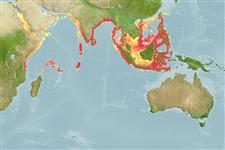Teleostei (teleosts) >
Pleuronectiformes (Flatfishes) >
Cynoglossidae (Tonguefishes) > Cynoglossinae
Etymology: Cynoglossus: Greek, kyon = dog + Greek, odous = teeth + Greek, glossa = tongue (Ref. 45335).
More on author: Hamilton.
Environment: milieu / climate zone / depth range / distribution range
Ecology
Marine; freshwater; brackish; demersal; amphidromous (Ref. 51243); depth range 10 - 961 m (Ref. 9494). Tropical; 25°N - 10°S, 32°E - 127°E
Indo-West Pacific: Malay Archipelago including Thailand, Viet Nam, the Philippines and Indonesia westward to seas and estuaries of India and Pakistan to the Red Sea (Ref. 9895).
Length at first maturity / Size / Weight / Age
Maturity: Lm 10.8, range 9 - 12.2 cm
Max length : 45.0 cm TL male/unsexed; (Ref. 11298); common length : 25.0 cm TL male/unsexed; (Ref. 9895)
Adults live mainly in shallow muddy and sandy bottoms of the continental shelf, sometimes entering estuaries and tidal rivers (Ref. 1479, 48637). Usually deeply buried in the substrate during the day, but out and hunting at night (Ref. 48637). They feed mainly on benthic invertebrates. Marketed mostly fresh and frozen; also dried-salted (Ref. 9895).
Menon, A.G.K., 1977. A systematic monograph of the tongue soles of the genus Cynoglossus Hamilton-Buchanan (Pisces: Cynoglossidae). Smithson. Contrib. Zool. (238):1-129. (Ref. 5297)
IUCN Red List Status (Ref. 130435: Version 2024-2)
Threat to humans
Harmless
Human uses
Fisheries: commercial
Tools
Special reports
Download XML
Internet sources
Estimates based on models
Preferred temperature (Ref.
123201): 8.8 - 18.2, mean 12.3 °C (based on 243 cells).
Phylogenetic diversity index (Ref.
82804): PD
50 = 0.5000 [Uniqueness, from 0.5 = low to 2.0 = high].
Bayesian length-weight: a=0.01047 (0.00432 - 0.02536), b=3.04 (2.83 - 3.25), in cm total length, based on LWR estimates for this (Sub)family-body shape (Ref.
93245).
Trophic level (Ref.
69278): 3.5 ±0.37 se; based on food items.
Resilience (Ref.
120179): Medium, minimum population doubling time 1.4 - 4.4 years (Fec = 360-35,926).
Fishing Vulnerability (Ref.
59153): Low to moderate vulnerability (35 of 100).
Nutrients (Ref.
124155): Calcium = 115 [50, 215] mg/100g; Iron = 0.899 [0.453, 1.673] mg/100g; Protein = 18.2 [15.8, 20.4] %; Omega3 = 0.176 [0.088, 0.368] g/100g; Selenium = 99 [44, 213] μg/100g; VitaminA = 11 [3, 40] μg/100g; Zinc = 0.977 [0.649, 1.475] mg/100g (wet weight);
